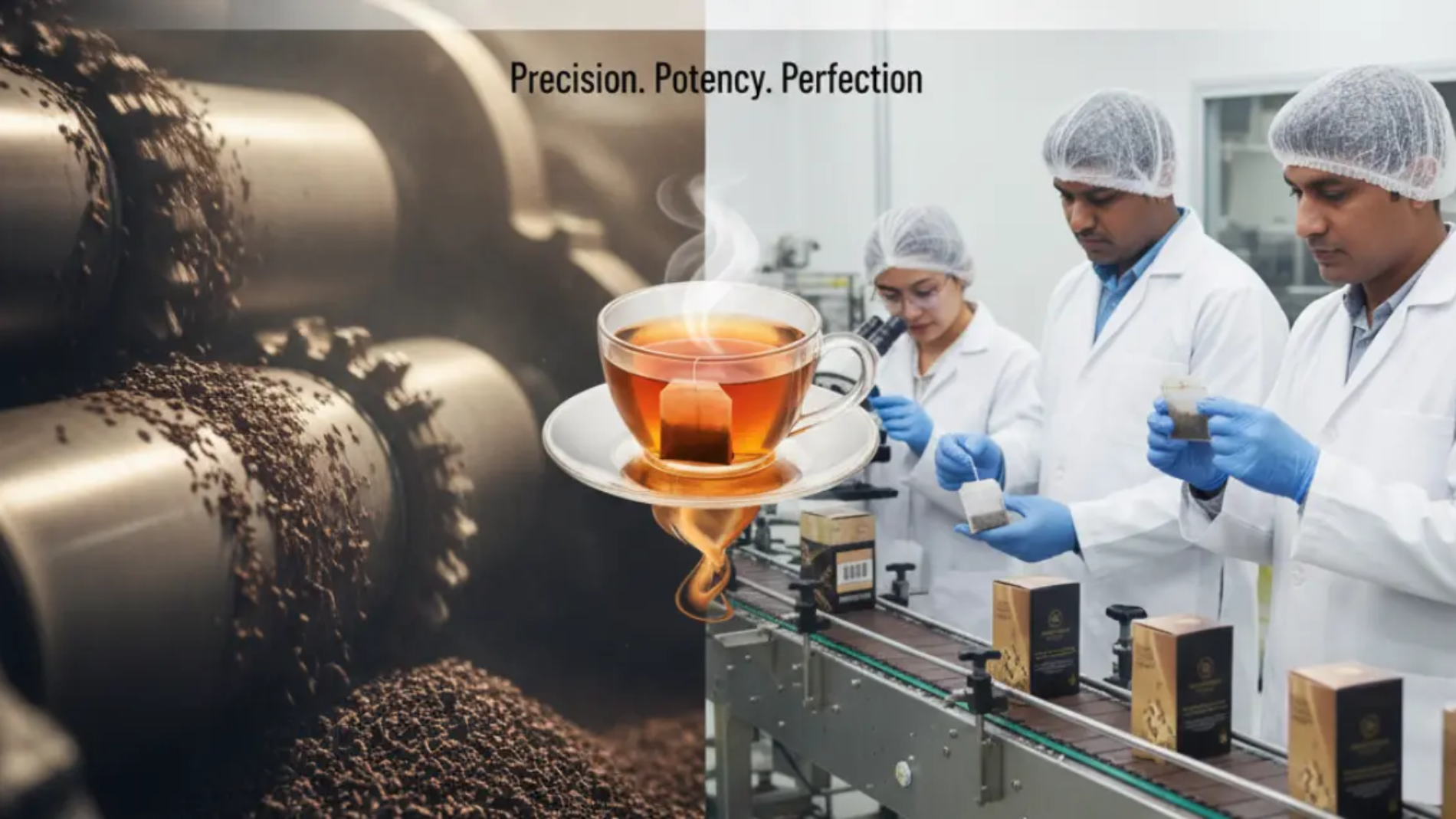The humble tea bag is a marvel of modern convenience. Billions are used every day around the world, with each one carrying the consumer’s expectation of a quick, flavourful, and satisfying cup of tea. For the global brands behind these products, delivering on that promise, consistently, across millions of units, is a monumental task. Their success hinges on one specific, powerful ingredient: CTC Black Tea Powder.
While the world of tea is vast, with artisanal whole-leaf varieties commanding premium prices, the engine room of the global tea bag industry is powered almost exclusively by CTC tea. But what is it about this particular type of Black Tea Powder that makes it so indispensable? The answer lies in a perfect alignment of its physical properties with the demands of the modern tea drinker. From our vantage point in Pune, at the heart of the world’s largest CTC-producing nation, the reasons are crystal clear.
1. The Need for Speed: Rapid and Powerful Infusion
A tea bag has a very short window—typically 2 to 3 minutes—to work its magic. Consumers expect a rich colour and strong flavour almost instantly. This is where the CTC method is unparalleled.
CTC stands for Crush, Tear, Curl, a highly mechanized process where fresh tea leaves are run through a series of cylindrical rollers that macerate and form them into small, hard, dense granules. These tiny pellets have an incredibly high surface-area-to-volume ratio. When they hit hot water, they release their flavour compounds and colour (known as liquor) immediately. An orthodox, whole-leaf tea, by contrast, needs much more time to unfurl and slowly release its essence, making it completely unsuitable for the fast pace of tea bag brewing.
2. Consistency is King: The Promise of Uniformity
A global brand cannot afford for its tea to taste different from one box to the next. The mechanized and standardized nature of the CTC process is the key to achieving this consistency. Unlike the variable, hand-crafted nature of orthodox teas, the CTC method ensures that the size, density, and chemical composition of the tea granules are remarkably uniform.
This means that every single tea bag in a production run of millions will brew a cup of tea with the exact same strength, colour, and taste profile. For a brand, this consistency is not just a feature; it is their core promise to the customer.
3. The Perfect Grade for the Perfect Bag
The CTC process allows for precise sorting of the Black Tea Powder into different grades based on particle size. This is a crucial element for tea bag manufacturing, as it allows blenders to create a precise “recipe” for their signature brew. The main tea grades used are:
Fannings (OF – Orange Fannings): Small particles that are larger than Dust. They form the base of many blends, providing a good balance of brisk flavour and rich colour.
Dust (D/PD – Dust/Pekoe Dust): The smallest particles. Dust infuses extremely quickly to produce the strongest and darkest liquor. It is a vital component for blends that need a powerful colour kick and a robust strength.
By specifying an exact ratio of these grades (e.g., 70% Fannings, 30% Dust), a company can craft a unique and completely replicable product.
Spice Up Your Business with Authentic Indian Flavors
Import and Export Excellence from India!

4. A Flavor Profile Built for Milk and Sugar
The vast majority of black tea bags sold globally are consumed with milk, sugar, or both. This requires a tea with a flavour profile that is strong enough to stand up to these additives without becoming weak or washed out.
CTC tea, particularly a robust Assam tea, is celebrated for its bold, brisk, and malty character. This inherent strength is its superpower. It cuts through the creaminess of milk and balances the sweetness of sugar, delivering a satisfying and full-bodied cup every time. A delicate, nuanced orthodox tea would be completely lost in this context.
5. The Economics of Efficiency and Supply
Finally, the realities of mass-market production demand an ingredient that is both cost-effective and available in massive quantities. The CTC method is a highly efficient, high-volume production process. This efficiency makes it a more affordable raw material than artisanal orthodox teas.
Furthermore, partnering with a reliable Indian tea supplier provides access to the world’s largest and most established CTC production ecosystem. This guarantees the kind of supply chain security that a global brand needs to operate without interruption.
In conclusion, the tea bag and CTC Black Tea Powder are a perfect match, a partnership born of the consumer’s need for a quick, strong, and reliable cup of tea.
Frequently Asked Questions (FAQs)
1. What do the CTC grades like BOP, OF, and PD actually mean?
They refer to the size of the tea granule. BOP (Broken Orange Pekoe) is larger, OF (Orange Fannings) is smaller, and PD (Pekoe Dust) is the smallest. Tea bags primarily use a blend of Fannings and Dust for quick, strong infusion.
2. Can orthodox (whole-leaf) tea be used in tea bags?
While some premium “pyramid” bags use whole-leaf tea, it’s not suitable for the standard flat tea bag. Orthodox leaves need more room and a much longer time (4-5 minutes) to unfurl and infuse properly, which doesn’t align with the typical consumer’s quick brewing habits.
3. Does CTC processing destroy the health benefits of tea?
No. While the process is different, CTC tea is still rich in the same antioxidants (flavonoids) and caffeine as orthodox tea. The primary difference is in the flavour profile and infusion speed, not the core health benefits.
4. What is the best CTC grade for a strong morning tea bag?
A blend with a higher proportion of Dust (PD) grade will produce a stronger, darker, and quicker brew, which is often preferred for a classic “English Breakfast” or “Irish Breakfast” style tea bag.
5. Why is Assam, India so famous for CTC tea?
The robust and malty character of the Assam tea leaf is perfectly suited to the CTC process. It creates a final product that is incredibly strong and flavourful, making Assam the world’s leading producer of high-quality CTC tea.
6. Does the “Crush, Tear, Curl” process sound harsh?
While the name sounds aggressive, it’s a precise and controlled process designed to rupture the tea leaf cells to promote rapid oxidation and infusion. It’s a method engineered for a specific, desirable result.
7. Is all Black Tea Powder made using the CTC method?
No. Orthodox black teas can also be ground into a powder, but this is less common for industrial use. When a B2B buyer refers to Black Tea Powder for mass-market applications, they are almost always referring to CTC grades.
8. How do I choose a good supplier for CTC Black Tea Powder?
Look for an Indian tea supplier with a proven track record, direct relationships with tea estates, and the ability to provide a comprehensive Certificate of Analysis (COA) for each batch, detailing the grade, quality, and food safety parameters.
About us
We bridge the gap between local producers and global markets, ensuring seamless trade facilitation with exceptional quality and reliability. We provide quick delivery services with customized packaging with all approval of International Certificates (Spices board India, MSME, IEC, fssai, FIEO, APEDA, EU certification, FDA and Many More)
Contact us
Shop No. 3, Ganesh Prestige Sr. No. 2/15, Near Laxmi Jewellers, Dhanakawadi, Pune – 411043, Maharashtra INDIA.
Call On
+91 9545205050
+91 9822422584



Leave A Comment